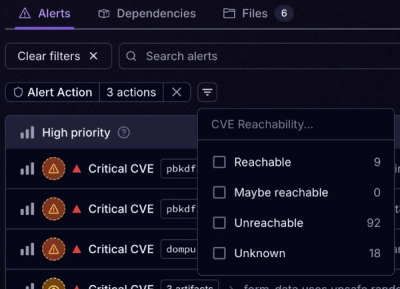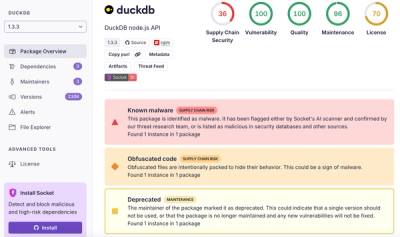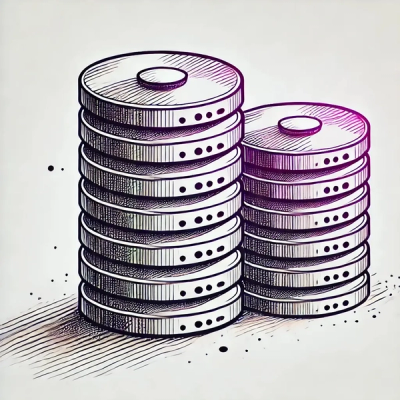
Product
Introducing Tier 1 Reachability: Precision CVE Triage for Enterprise Teams
Socket’s new Tier 1 Reachability filters out up to 80% of irrelevant CVEs, so security teams can focus on the vulnerabilities that matter.
@cipherstash/stashjs
Advanced tools
StashJS is a Typescript/Javascript API for the CipherStash always-encrypted searchable datastore.
Full documentation is available at docs.cipherstash.com as a well as an examples repo.
This tutorial will run you through installing the StashJS client library and writing a basic script to query a collection.
To complete this tutorial, you'll need a Linux or macOS computer (or virtual machine) on which you can install software.
The steps you'll go through are:
Install the CipherStash CLI on your local computer, to allow you to login to your workspace and start working with CipherStash.
Create your first collection, so that your records have somewhere to live.
Import some "test" records into the collection.
First, you need to sign up for an account. Signing up gives you access to the CipherStash Console web interface, and workspaces to store your data.
A CipherStash account is free, secure, and easy to create.
To sign up, visit https://console.cipherstash.com/?signup.
You can sign up with either an email, or with GitHub.
In order to create your account, we need to know:
Your E-mail Address; and
Your preferred password.
That's it. We don't need to know your full name, gender preference, or shoe size, so we don't ask for it.
As soon as you've created your account, you will be redirected to the Console home screen, which looks like this.

We've already created a workspace for you, so there's nothing more you need to do. For now, just make a note of the ID of your workspace, we'll use it later.
We do want to make sure your e-mail address is correct, so we send a verification e-mail to the e-mail address you gave. Please find the verification e-mail (it sometimes ends up in "Spam" or "Promotions", so check there too) and click the verification link. You will get this helpful, friendly message when that succeeds:

The CipherStash CLI is the primary way you'll interact with CipherStash. It allows you to login to a workspace, manage collections, and so on.
In order to install CipherStash CLI, you must have a Linux or macOS computer (or virtual machine) on which you can install software. Windows is not officially supported at this time, although you may have some success with WSL2.
The CipherStash CLI requires these dependencies:
⚠️ If you are confident installing these yourself, you can skip ahead.
Installing the dependencies using Homebrew:
brew install openssl node@16 rust
If you are running macOS on Apple Silicon, you'll need to install the nightly version of Rust, so cryptography works.
rustup default nightly
rustup update nightly
You will also need the Xcode command line tools which you can install by running:
xcode-select --install
Once you have the Node.js v16 installed, you need to configure npm so CipherStash CLI dependencies using Rust can install correctly:
mkdir ~/.npm-global
npm config set prefix '~/.npm-global'
echo 'export PATH="~/.npm-global/bin:$PATH"' >> ~/.profile
source ~/.profile
Specific steps will depend on your distribution.
Installing the build dependencies is typically a matter of asking your package manager nicely. For instance, on Fedora/Centos/Redhat:
sudo dnf install openssl-devel gmp-devel curl make automake gcc
Meanwhile, over in Debian/Ubuntu land:
sudo apt install build-essential curl libssl-dev
Installing Node.js is a slightly more involved proposition. Most Linux distributions don't ship Node.js v16 or higher. We recommend following the official Node.js documentation to get Node.js v16 installed.
If you are running Ubuntu, you can run:
curl -fsSL https://deb.nodesource.com/setup_16.x | sudo -E bash -
sudo apt-get install -y nodejs
Once you have the Node.js v16 installed, you need to configure npm so CipherStash CLI dependencies using Rust can install correctly:
mkdir ~/.npm-global
npm config set prefix '~/.npm-global'
echo 'export PATH="~/.npm-global/bin:$PATH"' >> ~/.profile
source ~/.profile
Lastly, you'll need a Rust toolchain to build the cryptography inside the CipherStash CLI.
curl --proto '=https' --tlsv1.2 -sSf https://sh.rustup.rs | sh
source $HOME/.cargo/env
If you're running Linux on ARM, you'll need to use Rust nightly, so cryptography works:
rustup default nightly
rustup update nightly
We're on the home stretch now.
To install the CipherStash CLI, you can use the Node.js package manager, npm, to install the stash command:
npm install -g @cipherstash/stash-cli
Exciting times, we're ready to get an access token and connect to CipherStash!
With the Workspace ID you saw on the console dashboard, run this command:
stash login --workspace <workspaceID>
This command will prompt you to visit an authentication URL under auth.cipherstash.com.
You might have to login again, if you haven't visited the Console in a while.
Once logged in, you should be presented with a page that looks like this:

Click the "Confirm" button to approve the creation of your access token.
All records in CipherStash are stored in a collection. You can think of a collection as loosely analogous to a table in a relational database, and records like rows.
For this tutorial, we're going to create a collection that stores information about movies. Then we'll import a bunch of data, to give you something to search on.
Collections are created using the stash create-collection command from the CipherStash CLI.
The command expects a collection name as well as a schema definition that describes the indexes and field types that are to be stored.
We've prepared some example data for your first collection. You can download its example schema from here, or by running the following command:
curl -Lo movies.schema.json https://cipherstash.com/examples/movies.schema.json
With the file downloaded, let's use movies.schema.json to create a movies collection:
stash create-collection movies --schema movies.schema.json
After a brief pause to talk to CipherStash, this command should return with the response "Collection 'movies' created.". That means everything worked perfectly.
Of course, an empty collection is not very useful. Thus, the next step is to import some records.
Or, if you'd like to know more about collection schemas, read on.
A collection in CipherStash is a named group of records that share a common purpose. Typically, these records will all have the same (or similar) fields, and will be queried in the same way -- and therefore will have the same indexes. The description of record fields and indexes is defined when you create the collection, by means of a schema.
CipherStash itself does not see any of this information -- the collection name, the fields and their types, and the index definitions are all encrypted before being sent to CipherStash to be stored. Only clients that have access to the decryption key can see anything useful about the collection.
For the movies collection we created above, we'll define the types of the movie's title, year of release, and running time (in minutes). Additional fields can be stored in the record, however the CipherStash client won't do any type checking on that data.
To facilitate searching for movies based on certain criteria, we'll also create the following indexes:
exactTitle, so we can find a movie record if we know it's precise title (eg "find the movie named 'Star Trek II: The Wrath of Khan'");matchTitle, so we can lookup movies using partial string matches, when we can only remember part of a movie's title (eg "find all the movies with 'Star Trek' in their name);year, so we can find movies made in a given year, or movies made over a range of years (eg "find all the movies made between 1980 and 1989");runningTime, so we can find movies whose running time is in a certain range (eg "find me all movies that run for at least four hours").CipherStash defines collection schemas using a specially-structured JSON object, which describes the record fields (and their types), and the indexes. For our collection of movies, with the fields and indexes listed above, the schema definition looks like this:
{
"type": {
"title": "string",
"year": "uint64",
"runningTime": "uint64"
},
"indexes": {
"exactTitle": { "kind": "exact", "field": "title" },
"matchTitle": {
"kind": "match",
"fields": ["title"],
"tokenFilters": [
{ "kind": "downcase" },
{ "kind": "ngram", "tokenLength": 3 }
],
"tokenizer": { "kind": "standard" }
},
"runningTime": { "kind": "range", "field": "runningTime" },
"year": { "kind": "range", "field": "year" }
}
}
If you'd like to know all the gory details of what the above JSON means, the CipherStash schema definition reference will explain everything.
Typically your application will store records in your collections as they're created by your application.
For initial setup or migrations, though, it's often useful to be able to bulk-import existing data.
You can do this using the stash import command.
Records to be imported should be saved as objects in a JSON array.
To get started, you can download some example movie data from cipherstash.com/examples/movies.data.json.
Try running the following command to download movies.data.json so we can import it into CipherStash in the next step.
curl -Lo movies.data.json https://cipherstash.com/examples/movies.data.json
After downloading, you should see that movies.data.json contains an array of objects that looks something like this:
;[
{
title: "Star Trek: The Motion Picture",
year: 1979,
runningTime: 132,
},
{
title: "Star Trek II: The Wrath of Khan",
year: 1982,
runningTime: 113,
},
{
title: "Star Trek III: The Search for Spock",
year: 1984,
runningTime: 105,
},
// ... and so on
]
Now that we have some example data, let's pass it to stash for import:
stash import movies --data movies.data.json
This will take a little while (and give your CPU some exercise), because the import process involves parsing and encrypting all the records as they get sent to CipherStash. Once the command returns, your data is imported and ready to go.
Having a collection full of records isn't much use unless you can retrieve the data when you need it. For this section of the tutorial, we'll introduce our "examples" codebase and look at some of those examples to show you how to perform queries against a collection.
We've collected a bunch of common code snippets into the StashJS examples git repository. These provide examples of how to do most common operations with CipherStash, using StashJS, our TypeScript/JavaScript client library. Most of these things you can also do using the stash CLI.
As querying is a complex operation, we've put several examples of how to do that in the stashjs-examples repo.
We'll download that repo, build the examples, and then run the querying examples so you can get a feel for how they work.
The easiest way to get the stashjs-examples repo is to clone it using git:
git clone https://github.com/cipherstash/stashjs-examples
This shouldn't take very long, as the repository isn't very large.
From there, it should just be a matter of installing the dependencies, and then running the TypeScript compiler:
npm install
npm run build
All of the pure-JavaScript example code gets written into the dist/ subdirectory, with a .js extension.
To run the simplest query example (an exact match on title), you can run the following command:
node dist/query-exact.js
This should output a single record from the movies collection, for the 2008 indie film "Lifelines" (originally titled "Wherever You Are").
All the other examples are run the same way, just change the filename.
If you examine the various querying examples (query-exact.ts, query-range.ts, query-match.ts, query-count.ts), you'll notice that most of the code is TypeScript boilerplate.
All that really changes in each script is the exact way that movies.query() is called.
In each case, the first argument is an inline function that describes the index and operator to apply to each record. If that function returns a match, then the record will be included in the result. For example:
movies.query(movie => movie.exactTitle.eq("Lifelines"))
Since all querying in CipherStash is against an index, not against a record field, we need to specify the name of a previously-defined index (in this case, exactTitle) to query.
Valid operators depend on the index type.
The available index types, and what operators are valid for each type, are listed in the reference documentation.
For an exact index, you can only use an eq ("exact equality") operator, and is typically used on boolean and string fields.
If you want to search for any string that matches another, you'll want the match index type.
Numeric types are best indexed with the range index type, which supports both equality and relational operators (such as less than, greater than, etc).
Examples of how to use each of these index types are provided in the examples repository.
In the snippet above, an array of matching records will be in the documents key of the object returned by movies.query().
The second argument to stash.query() allows you to specify keyword arguments that specify ordering, limits, and aggregation operations.
A simple example, to find the 10 oldest movies whose title matches the string "Life", looks like this:
movies.query(movie => movie.title.match("Life"), {
limit: 10,
order: [{ byIndex: "year", direction: "ASC" }],
})
The limit option takes a positive integer which specifies the maximum number of records to return.
If you don't specify any ordering, any record(s) that match may end up being returned.
Sorting results is controlled by the order option, which takes a list of ordering specifiers.
These are simply objects containing byIndex and direction keywords.
As the name suggests, ordering in CipherStash is controlled by indexes; any range index can be used for sorting results, in either "ASC" (ascending, ie "smallest value first") or "DESC" (descending, ie "largest value first") order.
Aggregation -- the process of combining records together -- is specified with the aggregation option.
At present, the only available aggregation operation is count, and can be applied to any index like this:
movies.query(movie => movie.title.match("Life"), {
aggregation: [{ ofIndex: "runningTime", aggregate: "count" }],
})
Aggregation results are returned in the aggregates key of the object returned by movies.query(), like this:
{
documents: [...],
aggregates: [
{ name: "count", value: 1234n }
]
}
Since when you're aggregating you often don't want the actual records themselves to be returned, you can specify the skipResults: true option, which will speed up the query and save sending back the record data that you won't care about anyway.
This is the end of our "Getting Started" tutorial. It's time to start using CipherStash to build your first secured application. If you'd like some help, we encourage you to sign up to our public discussion forum and post your questions.
const movieSchema = JSON.parse(`
{
"type": {
"title": "string",
"runningTime": "float64",
"year": "float64"
},
"indexes": {
"exactTitle": { "kind": "exact", "field": "title" },
"runningTime": { "kind": "range", "field": "runningTime" },
"year": { "kind": "range", "field": "year" },
"title": {
"kind": "match",
"fields": ["title"],
"tokenFilters": [
{ "kind": "downcase" },
{ "kind": "ngram", "tokenLength": 3 }
],
"tokenizer": { "kind": "standard" }
}
}
}
`)
const stash = await Stash.connect()
const movies = await stash.createCollection(movieSchema)
const stash = await Stash.connect()
const movies = await stash.loadCollection(movieSchema)
console.log(`Collection "${movies.name}" loaded`)
let id = await movies.put({
title: "The Matrix",
year: 1999,
runningTime: 136,
})
let queryResult = await movies.query(movie => movie.exactTitle.eq("Lifelines"), { limit: 10 })
let queryResult = await movies.query(movie => movie.title.match("star wa"), { limit: 10 })
let queryResult = await movies.query(movie => movie.year.lte(1940), {
limit: 5,
order: [{ byIndex: "year", direction: "DESC" }],
})
StashJS is currently maintained in a private monorepo which is synced to this repo when we push a new release to NPM.
We are in the process of moving StashJS (and its dependencies) out of our private monorepo and when that happens, this repo will be where all development happens in the open.
You may be wondering where all the tests are!
There are some unit tests in the StashJS repo but the bulk of the tests are are predominantly end-to-end tests against the CipherStash test infrastructure and they still live in our monorepo.
We have plans to move what tests we can to this repo and also convert some of those tests into unit tests that can be run by anyone hacking on this code.
We aren't there yet, but please be patient with us while we tease apart the necessary bits and bobs to make it happen.
The core encryption happens in a Rust package called ore.rs. More of StashJS will be converted from TypeScript to Rust code over time so that we can provide client bindings in as many languages as possible without rebuilding the world, and to ensure correctness and interoperability.
All of the parts of StashJS that are converted to Rust will also be publicly released under a permissive open source license and developed in the open.
FAQs
Datastore & Search API for CipherStash
We found that @cipherstash/stashjs demonstrated a not healthy version release cadence and project activity because the last version was released a year ago. It has 6 open source maintainers collaborating on the project.
Did you know?

Socket for GitHub automatically highlights issues in each pull request and monitors the health of all your open source dependencies. Discover the contents of your packages and block harmful activity before you install or update your dependencies.

Product
Socket’s new Tier 1 Reachability filters out up to 80% of irrelevant CVEs, so security teams can focus on the vulnerabilities that matter.

Research
/Security News
Ongoing npm supply chain attack spreads to DuckDB: multiple packages compromised with the same wallet-drainer malware.

Security News
The MCP Steering Committee has launched the official MCP Registry in preview, a central hub for discovering and publishing MCP servers.